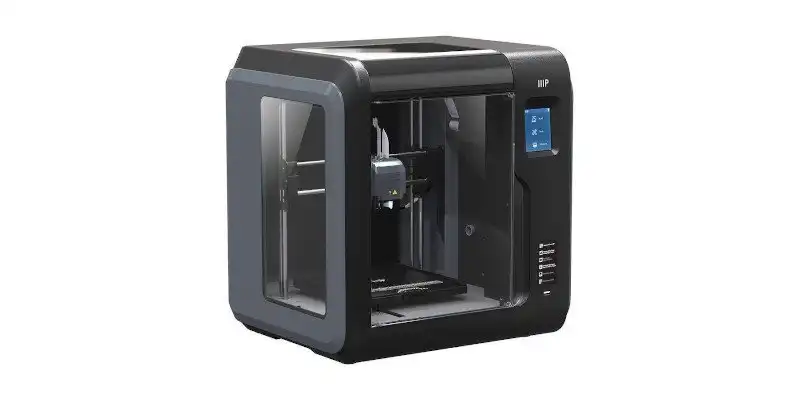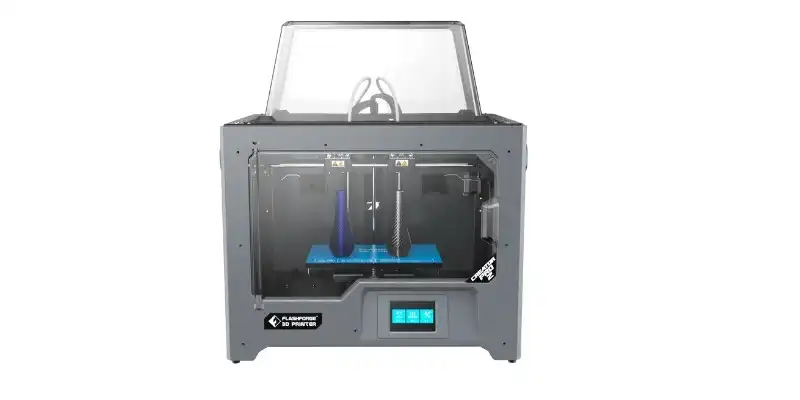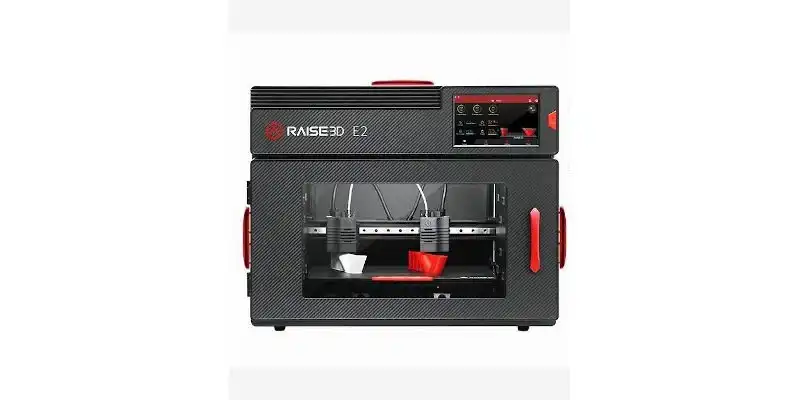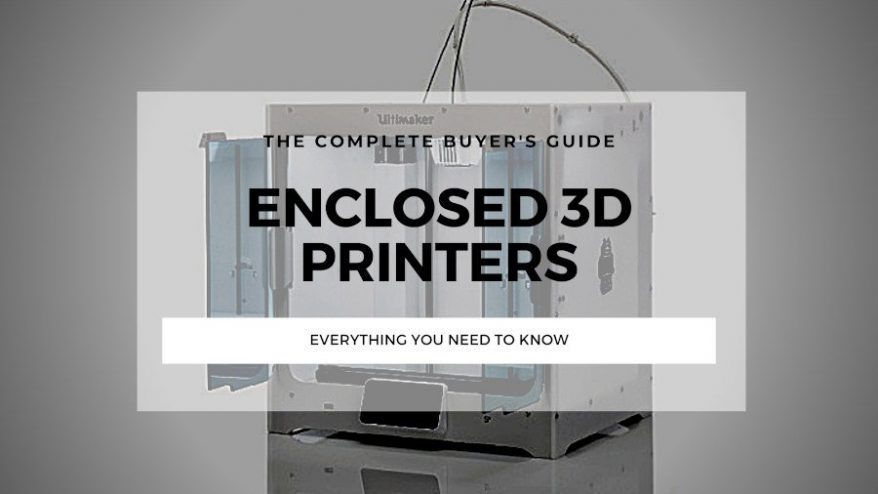
Enclosed 3D printers keep the cool air from getting to your print, causing warping or other issues. For basic filaments like PLA, 3D printer enclosures don’t make all the difference, but for trickier filaments like ABS and Nylon, they’ll save you time and time again.
Most cheap 3D printers are open 3D printers — they have no frame or enclosure (you can sometimes buy them separately) and print in the open air. Almost all 3D printer kits, like the Ender 3 and CR-10, are open air 3D printers (though you can buy an Ender 3 enclosure).
|
|
|
|
|
$449
|
$549-999
|
$3499
|
However, this can cause problems. ABS, a commonly used filament, warps when not cooled slowly.
Moreover, enclosed 3D printers keep the hot and dangerous-to-touch 3D printer parts away from yours and anyone else’s prying hands. This is especially important around children, making enclosed 3D printers some of the best 3D printers for kids.
Best 3D printers with enclosures
| Name and brand | Build Volume (mm) | Price | Where to buy | Alternative purchase option |
|---|---|---|---|---|
| Monoprice Voxel | 150 x 150 x 150 | $449 | Amazon here | Matterhackers here |
| Qidi Tech X-Pro | 230 x 150 x 150 | $499 | Amazon here | 3DJake UK & Europe |
| Bibo 2 | 216 x 187 x 160 | $679 | Amazon here | |
| Flashforge Creator Pro / Max | 227 x 148 x 150 | $699 / $879 | Amazon here | 3DJake UK & Europe |
| Dremel 3D45 | 254 x 152 x 170 | $1,599 | Matterhackers here | Dynamism Store here |
| Raise3D E2 | 330 x 240 x 240 | $3,499 | Matterhackers here | Dynamism Store here |
| Raise3D Pro2 / Pro2 Plus | 305 x 305 x 300(600) | $3,999 / $5,999 | Matterhackers here | Dynamism Store here |
| Ultimaker S5 | 330 x 240 x 300 | $5,995 | Dynamism Store here | Matterhackers here |
3DSourced is reader-supported. When you buy through links on our site, we may earn an affiliate commission. Learn more
Best enclosed 3D printers under $1,000
Flashforge Adventurer 3 Lite – cheapest enclosed 3D printer
- Price: $339 — Available at Flashforge Official store here / Available at Amazon here
- Build volume: 150 x 150 x 150 mm
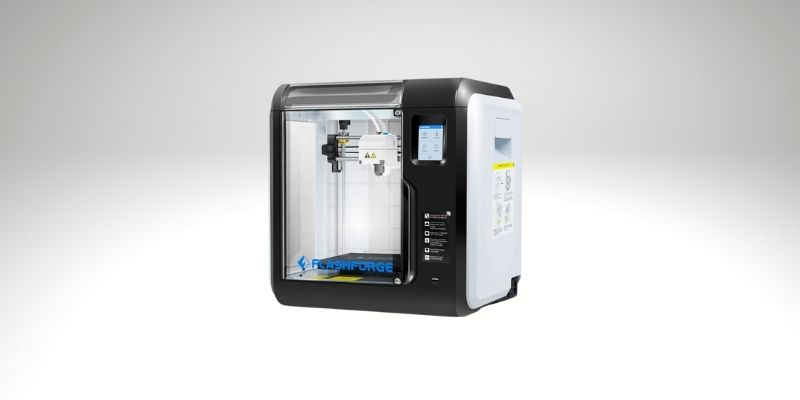
Pros
Reliable, beginner-friendly printer
Wi-Fi connectivity
Can print: PLA, ABS, Ultra Strong PLA, PLA Color Change, Metal-Filled, Wood, and High Speed PLA
Cons
Small build volume
The Flashforge Adventurer 3 Lite is a compact and quiet, fully enclosed beginner-friendly printer that offers frictionless out-of-the-box printing. There’s minimal setup involved, bar a well-guided five-point assisted calibration process, which makes it a top choice for first-timers or students looking to cut their 3D printing teeth free of hassle.
It’s modeled almost exactly on the full-fat Adventurer 3, minus a built-in camera and filament run-out detector. These minor features don’t detract significantly from the easy printing experience on offer here.
Aside from the sleek enclosed design, the Flashforge Adventurer 3 Lite has everything you need to work with thorny materials like ABS: a flexible, heated bed with a top temperature of 100°C and a max nozzle temperature of 240°C. With these features, you can also dabble in more exotic heat-sensitive filaments such as metal-fill, wood-fill, and others.
It also has a robust selection of connectivity options, including Wi-Fi and remote print monitoring, thanks to FlashForge’s 3D Cloud Print. A 150 x 150 x 150 mm build volume makes for a tight print area, one of the few complaints that stick when assessing the Flashforge Adventurer 3 Lite. You won’t have much luck printing bulky, towering parts, but this is easily remedied by printing in parts instead.
It’s also worth pointing out that the filament bay mounted on the side of the printer, while practical, isn’t geared to accommodate all types and brands of filament. You may need to fashion an external holder if your third-party filament of choice won’t fit.
Monoprice Voxel — budget enclosed 3D printer
- Price: $449 — Available on Amazon here / Available on Matterhackers here
- Build volume: 150 x 150 x 150 mm
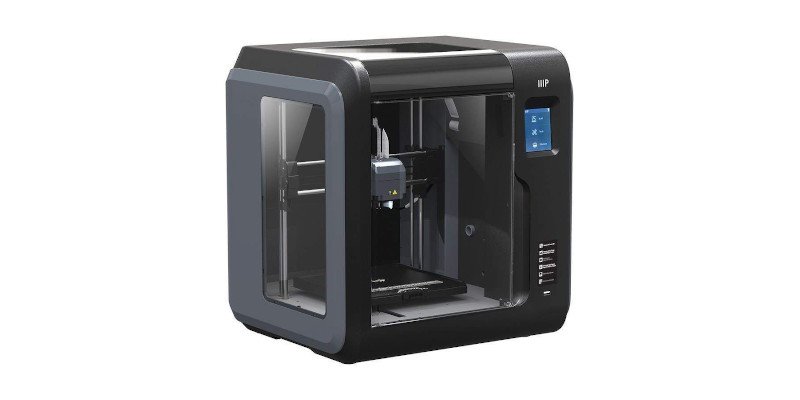
The cheapest enclosed 3D printer we recommend, the Monoprice Voxel is one of the best 3D printers for beginners. It’s super simple to set up (within 10 mins!), is easily operable via the touchscreen, can print via WiFi, and comes with 8GB onboard memory for storing 3D printer files. It comes with a few 3D models on file as well as some filament to get you started, so you can really go from unboxing to printing in minutes.
If you’re brand new to 3D printing and not too technical, the assisted leveling reduces expertise to just a tap. It also comes fully assembled so you don’t need any DIY skills, surprising considering most printers in this price range are 3D printer kits. It can also connect to the Polar Cloud, allowing you to remotely control and monitor your printer, and even do so for multiple printers simultaneously.
Key points:
- Cheap enclosed 3D printer
- Beginner friendly
- WiFi printing and touchscreen on an affordable machine
- Materials: ABS, PLA, PETG, Flexibles
QIDI Tech X-Pro — great 3D printer with enclosure for $500
- Price: $500 — Available on Amazon here / Available on 3DJake UK & Europe here
- Build volume: 230 x 150 x 150 mm
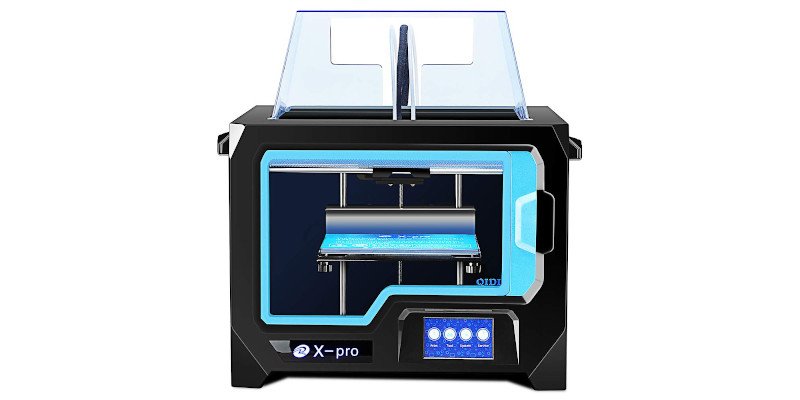
One of the most popular low cost 3D printers of the last year, the Qidi Tech X-Pro offers reliability, accuracy, dual extrusion, and an effective enclosed printing area, all at $500.
Layer thicknesses start at 0.05mm, and the printer can print at speeds between 30 and 150mm/s — though at these high speeds print quality will noticeably deteriorate. It’s Mac and Windows compatible, and can print via WiFi, as well as via USB or ethernet connections.
The flexible, removable build plate makes for easy print removal with minimal damage, and it comes with Qidi Tech’s own QidiPrint 3D slicer. Overall, it’s one of the best enclosed 3D printers for $500.
Key points:
- Large 4.5 inch touchscreen for ergonomic printing
- Flexible build plate
- WiFi printing and dual extrusion for $500
- Materials: ABS, PLA and PETG
Flashforge Creator Pro 2 – Top Affordable IDEX Printer
- Price: Available at Flashforge Official store here / Check price on Amazon here
- Build volume: 200 x 148 x 150 mm
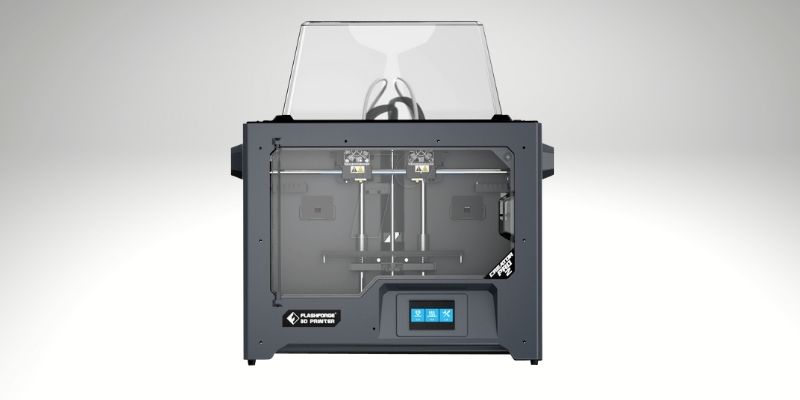
A well-tooled refresh of the classic Creator Pro, the Flashforge Creator Pro 2 offers all the balmy goodness of an enclosure with features you wouldn’t expect in the $600 to $700 range. We see it as a perfect second printer for a maker that’s already tackled that initial learning curve on a budget FDM kit and is now looking for something more versatile and feature-rich.
While the Flashforge Creator Pro 2 features a sturdy, well-built enclosed print chamber suitable for both ABS and PLA thanks to the removable acrylic top cover, it’s the independent dual extruder system that sets it apart from the other best enclosed 3D printers out there.
An IDEX system is almost unheard of at this price, giving makers the possibility to spice things up with mirror prints, duplicate prints, soluble support structures, and even printing multiple materials or colors simultaneously. It’s one for complex prints with vertiginous overhangs or an ideal tool to help a teacher pump out as many student-designed prints as fast as possible.
These two central points aside, the Flashforge Creator Pro 2 rounds off the offering with a touchscreen interface, a 200 x 148 x 150 mm build volume, and compatibility with PLA, Pearl PLA, ABS, ABS Pro, PVA, and HIPS materials.
It’s worth noting that Flashforge made the unfortunate choice of anchoring the Creator Pro 2 to its in-house FlashPrint slicer. It does the job well enough but doesn’t have the versatility of an open-source software kit like Cura. Not necessarily a deal-breaker, especially for 3D printing newcomers or educators that want straightforward software and pre-loaded settings specifically tuned to work with the Creator Pro 2 from the get-go.
Key points:
- Affordable independent dual extruder system
- Fully-enclosed print chamber
- Materials: PLA, Pearl PLA, ABS, ABS Pro, PVA, and HIPS
BIBO 2
- Price: $679 — Available on Amazon here
- Build volume: 216 x 187 x 160 mm
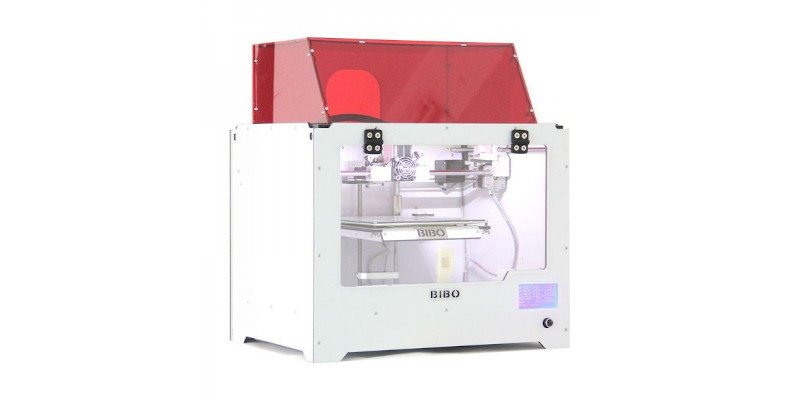
Full of character and affordable for hobbyist makers, the Bibo 2 offers 50-micron accuracy, dual extrusion, and WiFi printing, all at well under $1,000.
Though not an IDEX printer, this enclosed 3D printer still offers copy printing modes for printing two of the same objects simultaneously. It has an easy to use touchscreen — not a given in this price range — and has filament run out detection to avoid ruining prints.
As well as a 3D printer enclosure for effective ABS and Nylon 3D printing, the Bibo is built in a stable and strong aluminium frame, minimizing unwanted vibrations that can slightly affect performance and print quality. Overall, for the price it’s a great enclosed 3D printer — and it can also come with a laser engraver kit.
Key points:
- WiFi printing, dual extrusion, and a touchscreen, all for just over $500
- 50-micron minimum layer heights
- Claims to be able to print Polycarbonate, but also says max temperature is 270C
- Materials: PLA, ABS, HIPS, flexible filaments, PETG, Nylon, PC, Carbon fiber
Best prosumer enclosed 3D printers
Dremel 3D45
- Price: $1,599 — Available on Matterhackers / Available on Dynamism / Available on Amazon
- Build volume: 254 x 152 x 170 mm
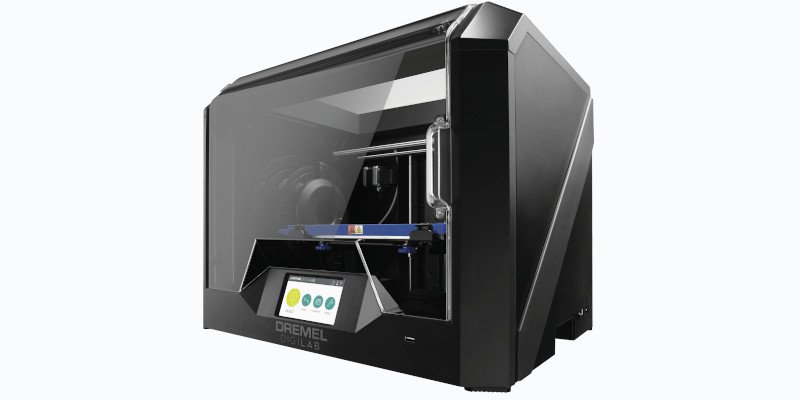
Accurate, versatile and perfect for teaching 3D printing in schools, the Dremel 3D45 builds on almost a century of Dremel manufacturing excellence. Boasting up to 50-micron accuracy, connectable via WiFi as well as by USB or ethernet cable, and compatible on Mac or Windows computers as well as iPads, the Dremel Digilab 3D45 perfectly complements any school or business prototyping environment.
The heated plate means it can print Nylon and Eco-ABS, and the built-in HD camera makes for easy remote monitoring of print progress, which can be easily done via their cloud 3D printing software.
If you do run into any problems, Dremel’s USA-based support are on hand to help you. Overall, it’s a reliable and accurate enclosed 3D printer that offers good build volume and results for the price.
Key points:
- Effective auto leveling system
- Highly-rated customer support
- Versatile
- Materials: PLA, PETG, Eco-ABS, Nylon
Raise3D E2
- Price: $3,499 — Available on Matterhackers / Available on Dynamism / Available on Amazon
- Build volume: 330 x 240 x 240 mm
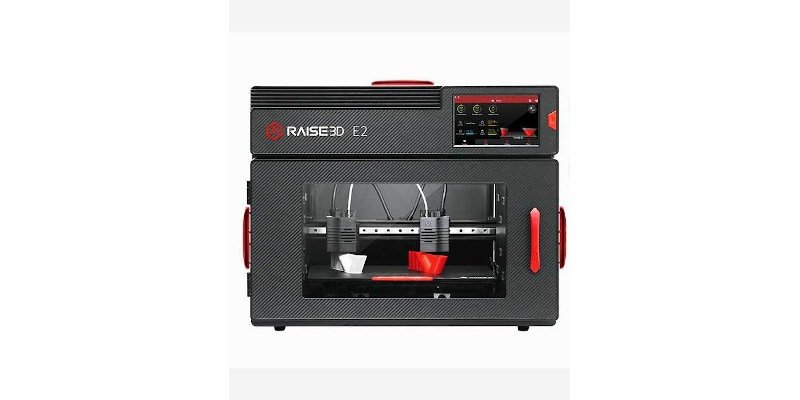
Raise3D’s large, enclosed 3D printer brings IDEX dual extruder 3D printing to their already impressive 3D printing range. IDEX 3D printer extruders can move independently, greatly increasing print speeds and efficiency, especially for printing multiple similar or identical parts.
The E2 features two main modes:
- Mirror mode: 3D prints inverted mirror versions of your model, for example a left and right-footed shoe sole, simultaneously.
- Duplication mode: uses both extruders in synchrony, printing two identical objects at the same time and doubling printing efficiency.
The E2’s 3D printer enclosure keeps the heat in, and everything else out. If the door is opened during printing, progress is immediately paused to ensure nobody is burned or harmed by the extruder or heated bed. The E2 also has an effective air filtration system, removing melted plastic particles and aromas, as well as filament run out sensors and power outage recovery features.
Key points:
- Build volume drops to 295 x 240 x 240 mm if using the dual extruder
- Useful Mirror & Duplication modes
- Built-in safety measures
- Materials: PLA, ABS, HIPS, PC, TPU & TPE, PETG, Nylon, PP, ASA, PVA, Glass-infused, Metal-filled, Carbon fiber-filled, and wood-filled filaments
Best upper-range 3D printers with enclosures
Raise3D Pro2 / Pro2 Plus
- Price: $3,999 / $5,999 — Available on Matterhackers here / Available on Dynamism here
- Build volume: 305 x 305 x 300 (605) mm
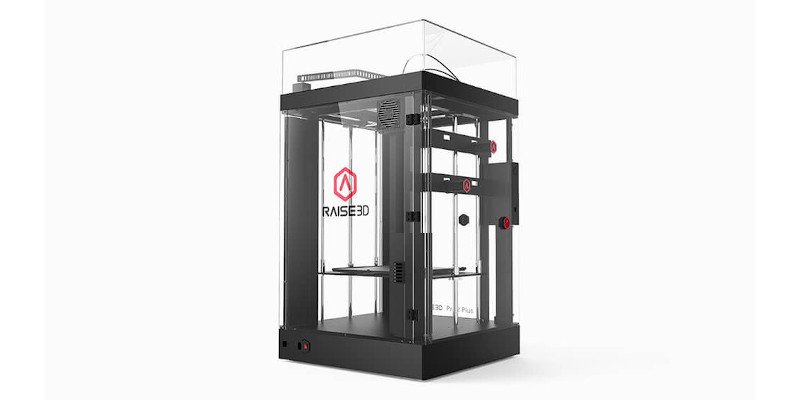
A true workhorse 3D printer with full enclosure, the Raise3D Pro2 range offer incredible accuracy, material compatibility, great workflow, and a host of other key features.
The standard Pro2 already features a very large build area, with the Pro2 Plus expanding the z-axis range up to up 605 mm tall parts. The extruders can reach 300C for even the toughest filaments like PC, and the dual extruders make for effective soluble support printing as well as 3D printing multiple colors.
With minimum layer heights of 0.01mm possible, the Pro2 enclosed 3D printers can print incredibly crisp and intricately detailed parts. Switch out the nozzle for a smaller nozzle, and zone in on small details for a fantastic finish. The built-in camera makes monitoring prints easy, and the 7-inch touchscreen offers data and a simple to use overall workflow.
Key points:
- Dual extruder build volume: 280 x 305x 300 mm
- Complete printer: accurate, reliable, enclosed, versatile.
- Materials: PLA, ABS, HIPS, PC, TPU, Nylon, ASA, PETG, PVA, Glass, Carbon fiber, Wood
Ultimaker S5 (with enclosure kit)
- Price: $5,995 — Available at Dynamism here / Available on Matterhackers here / 3DPrima Europe here
- Build volume: 330 x 240 x 300 mm
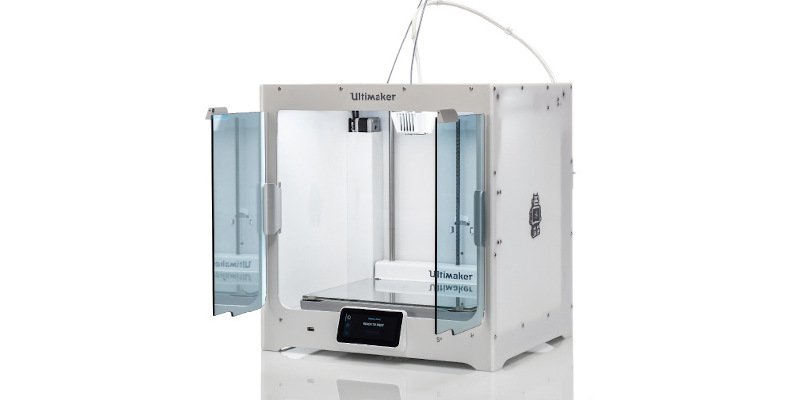
Capable of 3D printing industrial-grade parts with up to 20-micron layer resolutions, it doesn’t get much better than the Ultimaker S5. An enclosed 3D printer that becomes even more effective and safe with the S5 Pro Bundle, the S5 offers reliable and repeatable dual extrusion, at astonishing accuracy, even with abrasive filaments like glass and carbon fiber filaments.
Though Ultimaker make their own filaments, the S5 is open and can be used with any 2.85mm filaments. It prints via WiFi as well as a variety of other methods, and can be monitored remotely via the built-in camera.
If you purchase the S5 Pro Bundle, you gain access to 24/7 automated material handling, air filtration and heat control for up to 6 filaments, as well as the Air Manager which further encloses the 3D printer.
Key points:
- Excellent precision and print quality
- Reliable and effective with many materials
- Pro Bundle makes it an even more effective enclosed 3D printer
- Materials: PLA, CPE, NYLON, ABS, Glass, Carbon fiber, PC, PVA, PP, TPU
Buyer’s Guide – What To Consider
Fully or Partially-Enclosed Chamber
Partially-enclosed printers are somewhat of an oddity as they don’t offer the ideal environment for printing either of the two main filament types, ABS and PLA. However, they provide an extra layer of safety, useful for education or makers with children. We recommend a fully-enclosed chamber if you plan to print using ABS and an open design if PLA is your filament of choice. If you’re looking to print with ABS and PLA, choose an enclosed printer with removable covers.
Build Volume
Build volume represents the printable area available to you on an enclosed printer. In other words, it’s a measure of the size and type of prints you can make. If you plan on making large prints or multiple copies, we recommend printers with large volumes, such as the Ultimaker S5.
Material Compatibility
By design, an enclosed 3D printer offers compatibility with a broader range of material types due to the capacity to maintain a higher temperature around prints and keep cool air out. ABS is by far the most common filament type for enclosed chambers, but you’ll also find printers that can tackle nylon, PC, and other heat-sensitive materials. PLA is also a possibility as long as the printer’s covers are removable as the material requires cooler ambient temperatures for the best results.
Heated Bed
Given that the whole point of an enclosed chamber is to provide a stable thermal environment to print trickier filament like ABS, a heated bed is a must-have. It helps provide an additional heat source directly below the print, which helps with layer adhesion and slows the cooling rate, which avoids unwanted imperfections like warping and curling.
Connectivity
Connectivity determines how you interact with the printer, whether sending sliced prints or fine-tuning settings. An SD card reader is more or less standard, as is USB in many cases, but for ease of use, nothing beats Wi-Fi connectivity and, by extension, cloud-based printing and monitoring.
Layer Resolution
Layer resolution indicates the lowest layer height a print can produce. Opt for a printer with a lower layer resolution for parts with more detail, such as the 20 microns on the Ultimaker S5. On an enclosed FDM printer, a 100-micron layer resolution is relatively standard and allows you to create a wide range of parts.
Filters
If you’re buying an enclosed chamber, chances are ABS is part of your printing plans. ABS is not just odorous but also produces potentially harmful fumes. Having a printer equipped with filters, either carbon or HEPA, helps extract the most toxic elements from the fumes. Additionally, we also recommend working with ABS in a well-ventilated space.
Touchscreen
For convenience, we recommend an enclosed 3D printer with a touchscreen. After all, we’re all accustomed to scrolling and swiping on our phones, so it makes sense to want the same functionality and familiar interface when working with a 3D printer. Most modern printers feature a touchscreen as standard.
Price
Enclosed printers tend to bump up the price as you pay for the extra manufacturing and design involved. But, with the ever-growing popularity of the race-to-the-bottom budget category, enclosed chamber printers are more affordable than ever before. You can easily buy a reliable enclosed 3D printer for under $400. Naturally, if you have the budget, new professional-grade printers priced in the thousands of dollars hit store shelves each year, too.
Advantages of Enclosed 3D Printers
Better ABS and Nylon 3D printing
Enclosures can cool parts down more slowly, and maintain more consistent and high heats within the build chamber. This reduces warping and splitting during the printing process.
Much safer
3D printer enclosures keep hot parts like the nozzle and heated bed away from kids if you have family at home, or if 3D printing at schools.
Quieter
The enclosed area keeps noise in, making them ideal quiet 3D printers. Enclosures contain the whirring and buzzing of the printing process, a genuine boon if you’re printing at home or in a confined space with bad acoustics likely to amplify noise levels.
Sturdier and more reliable
Enclosed 3D printers are typically built with a sturdy cuboid structure, with four walls that prevent vibrations and other factors from worsening print quality.
Noise Reduction
enclosures help keep noise levels down by containing the whirring and buzzing of the printing process, a genuine boon if you’re printing at home or in a confined space with bad acoustics likely to amplify noise levels.
Disadvantages of Enclosed 3D Printers
More expensive – 3D printers with enclosures cost more than open FDM printers. The logic is evident here; manufacturers have to spend more on raw materials and the assembly process, costs that invariably trickle down to consumers.
Difficult maintenance and troubleshooting – Due to the enclosed design, maintenance is much harder on an enclosed 3D printer. Cleaning, replacing, troubleshooting, or upgrading parts is far more troublesome than an open-design 3D printer.
FAQs
What Does a 3D Printer Enclosure Do?
Enclosures help enhance printing performance by keeping hot air in and cold air/drafts out. For heat-sensitive materials like ABS, a stable higher temperature environment is crucial for proper layer adhesion and to reduce the chances of warping, curling, and other issues. Similarly, an enclosure helps keep dust and dirt away from the printer’s parts and the print itself; essential for successful printing as impurities can affect adhesion and print quality.
Are Enclosed 3D Printers Safer? Why?
Yes. An enclosure keeps hot and moving parts away from curious fingers and hands, lessening the likelihood of injury compared to open-design printers where all the parts are exposed and readily accessible. If you live with children or work in an educational setting alongside younger students, an enclosed 3D printer provides peace of mind. Additionally, the filters often mounted in enclosed printers rid fumes of toxic elements.
How to Maintain an Enclosed 3D Printer?
Enclosed 3D printer maintenance is identical to what’s involved in keeping an open-design printer in tip-top shape: regular cleaning of the bed and nozzle, firmware updates, routine inspection of parts for wear and tear, and bed leveling/calibration at regular intervals.
Are Enclosed 3D Printers Better?
If you’re looking to print with ABS, yes. An enclosure provides the right, sustained ambient temperature for ABS to thrive. On the other hand, if you plan to print with PLA, an open-design printer stands as a better option. PLA requires plenty of cool air and ventilation to flourish.
